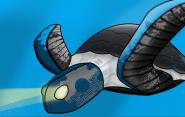With Turtle-Inspired Project, Rebecca Kramer Wins Young Investigator Award

Rebecca Kramer, assistant professor of mechanical engineering & materials science, has been awarded a Young Investigator Research Program grant from the Office of Naval Research (ONR). With this award, Kramer will create the first morphing robotic limb capable of matching its configuration and stiffness to its environment. She credits her inspiration for the idea to biological sea turtles and terrestrial tortoises.

“Sea turtles and tortoises are anatomically similar. The major difference is morphology of the limbs,” she said. “Sea turtles have flippers for swimming, stability control, and maneuvering, whereas tortoises have legs for support of the body and movement on land. Our limb design will allow movement in both environments while permitting functionality in the tidal zone.’”
Kramer’s lab, “The Faboratory,” officially moves to Yale this summer from Purdue University, where Kramer has been since 2013. Her previous honors and awards include being named to Forbes 30 under 30 list, and receiving the NSF CAREER Award, the NASA Early Career Faculty Award, and the AFOSR Young Investigator Award.
With their flippers, sea turtles are remarkably swift in the water. Their movements on land, though, aren’t nearly as impressive. Conversely, tortoises move fine on land and but are far less efficient swimmers. Fortunately for both, neither leave their native terrain very often. For many Navy vehicles and devices, though, land-to-water capabilities are crucial. The three distinct environmental conditions of the shoreline - stable open water, turbulent surf zones, and dry land – are particularly tricky for robotic systems to navigate.

Drawing from the differences and similarities of turtles and tortoises, Kramer’s lab will develop what’s known as a Biomimetic Unmanned Untethered Vehicle (BUUV) with a reconfigurable actuation system that can change from a flipper optimized for water to a leg optimized for land. To make the transformation from the tortoise-like phase of the robotic limb (nearly circular in cross-section to provide support for walking) to the flattened shape of the turtle’s flipper, Kramer will use materials that can change in stiffness to lock and unlock into the two configurations.

“We have developed variable-stiffness fluidic bending actuators that can reconfigure between a thin, flat state and an inflated, bent state. Distributing these actuators along a limb will allow us to morph between the flipper and leg configurations,” Kramer said. “Distributing actuation, sensing and variable stiffness throughout the entire limb structure is one of the goals for this project.”
This approach, she said, will avoid many of the design compromises that hinder the current generation of amphibious robots. As Kramer notes, soft and reconfigurable robots that mimic systems in nature have the potential to operate in the kinds of environments that spell trouble for traditional robots.
When the three-year project is complete, Kramer said the system should be at least as efficient in each mode as the tortoise and turtle limbs are in nature. Not only would the system have more control than traditional robots in the varying environments, they would also operate using less power. Potential applications would include payload delivery, mine-detection and disposal, surveillance, environmental monitoring and diver support.
 For the project, Kramer will collaborate with Frank Fish, professor of biology at West Chester University, who specializes in locomotion efficiency in certain animals. She and her team will also visit more zoos and aquariums, possibly observing turtles and tortoises in transitional zones to watch how they crawl up onto land, or dive back into the water.
For the project, Kramer will collaborate with Frank Fish, professor of biology at West Chester University, who specializes in locomotion efficiency in certain animals. She and her team will also visit more zoos and aquariums, possibly observing turtles and tortoises in transitional zones to watch how they crawl up onto land, or dive back into the water.
The project is a natural progression for the Faboratory, which specializes in soft robotics. With research that’s supported by NASA, the Air Force Office of Scientific Research (AFOSR), the National Science Foundation (NSF), the Defense Advanced Research Projects Agency (DARPA) and Intel, Kramer’s team is uniquely positioned to address the challenges associated with soft, biomimetic robots from a materials and manufacturing perspective.
The Young Investigator awards were made to 33 young scientists, selected from over 360 highly qualified applicants based on past performance, technical merit, potential scientific breakthrough and long-term university commitment. ONR Young Investigator Program Grant awardees represent 25 academic institutions nationwide, in disciplines ranging from robotics and lasers to nanomaterials and autonomous navigation. Typical grants are $510,000 over a three-year period.

